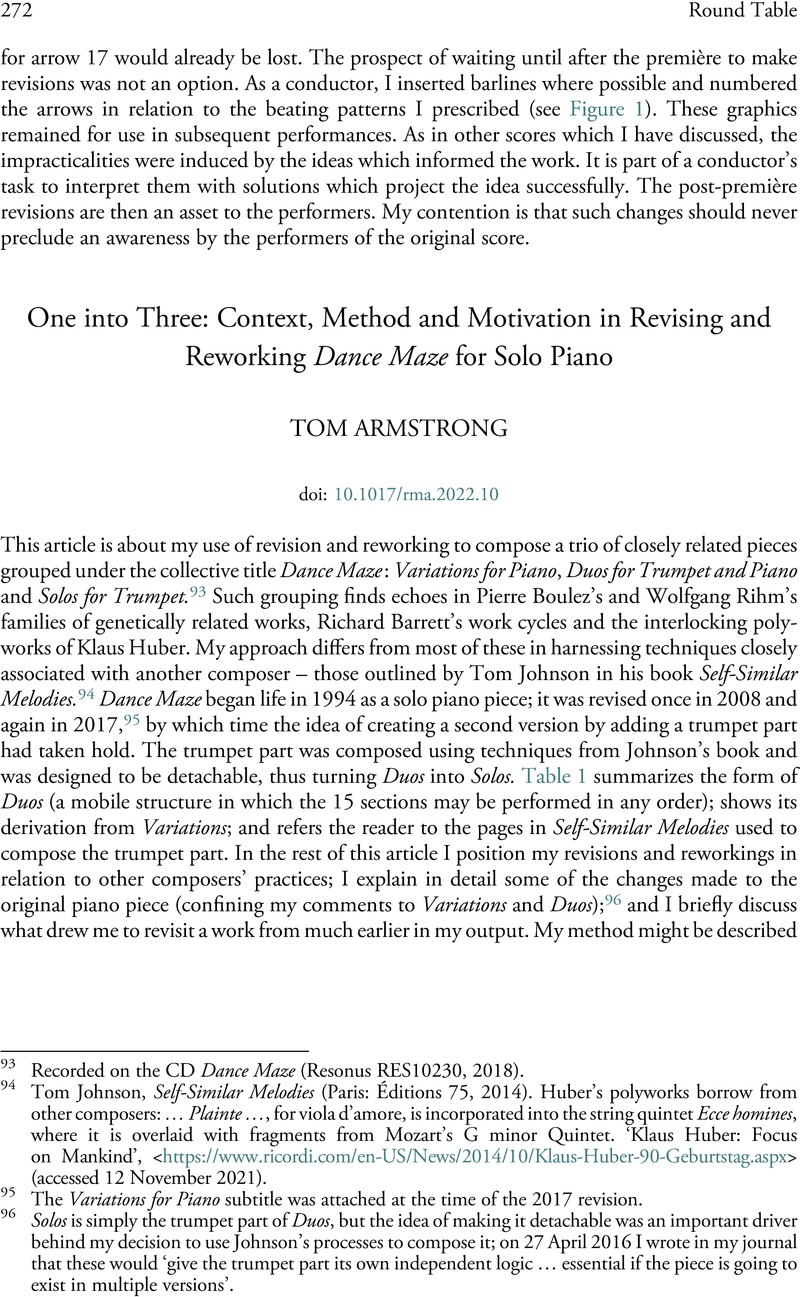No CrossRef data available.
Article contents
One into Three: Context, Method and Motivation in Revising and Reworking Dance Maze for Solo Piano
Published online by Cambridge University Press: 16 May 2022
Abstract

- Type
- Roundtable
- Information
- Copyright
- © The Author(s), 2022. Published by Cambridge University Press on behalf of The Royal Musical Association
References
93 Recorded on the CD Dance Maze (Resonus RES10230, 2018).
94 Tom Johnson, Self-Similar Melodies (Paris: Éditions 75, 2014). Huber’s polyworks borrow from other composers: … Plainte …, for viola d’amore, is incorporated into the string quintet Ecce homines, where it is overlaid with fragments from Mozart’s G minor Quintet. ‘Klaus Huber: Focus on Mankind’, <https://www.ricordi.com/en-US/News/2014/10/Klaus-Huber-90-Geburtstag.aspx> (accessed 12 November 2021).
95 The Variations for Piano subtitle was attached at the time of the 2017 revision.
96 Solos is simply the trumpet part of Duos, but the idea of making it detachable was an important driver behind my decision to use Johnson’s processes to compose it; on 27 April 2016 I wrote in my journal that these would ‘give the trumpet part its own independent logic … essential if the piece is going to exist in multiple versions’.
97 Recordings were made via the Com-Note composer’s notebook app, available from Google Play.
98 Joseph R. Salem, ‘Boulez Revised: Compositional Process as Aesthetic Critique in the Composer’s Formative Works’ (Ph.D. dissertation, University of Yale, 2014), i.
99 Salem points out that in Boulez’s work earlier versions are often marginalized in performance. This is very much not the case with Variations and Duos; the coexistence of these viable versions is key to the aesthetic critique discussed below.
100 Eclecticism was not an aim in reworking Variations; in a Com-Note narrative from 12 August 2016, I mention that ‘not sounding like Tom Johnson’ has proved easier than envisaged. But, as this had to be balanced against the need to ‘try and remain true to the logic of these self-similar melodies’ (12 August 2016), there are moments in Duos that approach Johnson’s style.
101 Johnson, Self-Similar Melodies, 109.
102 The choice of mapping is arbitrary, but follows Johnson’s procedure of translating numbers, for example the 1233233 of bar 3, into scale steps.
103 Johnson, Self-Similar Melodies, 83.
104 Ibid., 90.
105 Williams, Alastair, Music in Germany since 1968 (Cambridge: Cambridge University Press, 2013)CrossRefGoogle Scholar.
106 There is often a very close correspondence between the processes exemplified in the book and Johnson’s own music, characterized as it is by the explicit presentation of mathematical phenomena often in an unadorned, monophonic style – see Rational Melodies (1982), for example.
107 Armstrong, journal entry (21 February 2016).
108 Armstrong, journal entry.
109 Miller, Leta, ‘Lou Harrison and the Aesthetics of Revision, Alteration, and Self-Borrowing’, Twentieth-Century Music, 2 (2005), 79–107 CrossRefGoogle Scholar (p. 80).
110 Salem, ‘Boulez Revised’.
111 Ibid., 2.
112 Each section of Variations is linked to its neighbours by metric modulations.
113 This is the reason for the different alignments of trumpet and piano shown in Table 1 – to avoid creating a series of ‘chunks’ in which the instruments always begin and end together.
114 Berio, Luciano, Remembering the Future (Cambridge, MA: Harvard University Press, 2006), 97–8CrossRefGoogle Scholar.
115 Parker, Roger, Remaking the Song: Operatic Visions and Revisions from Handel to Berio (Berkeley and Los Angeles, CA: University of California Press, 2006)Google Scholar.
116 Mariella Devia transposes some declamatory passages in the opera an octave higher to avoid the lower part of her range.
117 Parker, Remaking the Song, 21.




